Shuri Castle, Seifa-Utaki, and others: 20 years since the UNESCO World Heritage List inscription
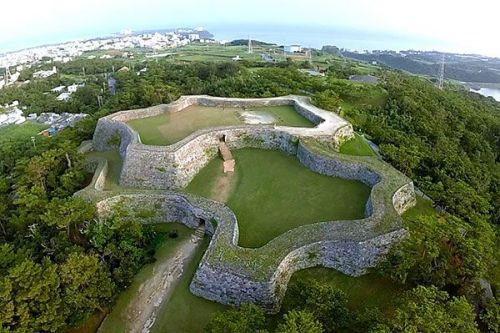
Zakimi Castle Ruins in Zakimi, Yomitan
November 30, 2020 Ryukyu Shimpo
Nov 30 marks the 20th anniversary since nine sites throughout Okinawa were added to the United Nations Educational, Scientific and Cultural Organization’s World Heritage List as: “Gusuku and Related Heritage Sites of the Kingdom of Ryukyu.” The heritage sites are castles and utakis (Okinawan term for a sacred place), cultivated by the Ryukyu Kingdom’s unique culture and history. The seven municipalities where the World Heritage Sites are located are taking this occasion to improve the facilities near the sites to attract tourists and revitalize the community. Below, we look back on the 20 years of preserving and operating each of the sites and the challenges they face today.

Nakagusuku Castle Remains in Tomari, Nakagusuku and Oshiro, Kitanakagusuku
The nine sites inscribed on the UNESCO World Heritage List are Nakijin Castle (Nakijin Village), Zakimi Castle (Yomitan Village), Katsuren Castle (Uruma City), Nakagusuku Castle (Nakagusuku Village and Kitanakagusuku Village), Shuri Castle (Naha City), Shikinaen (Naha City), Tamaudun (Naha City), Sonohyan-Utaki-Ishimon (Naha City), and Seifa-Utaki (Nanjyo City).
Each municipality is under pressure to improve its crisis management in excessive tourism, natural disasters, and the spread of infectious diseases, including the novel coronavirus.
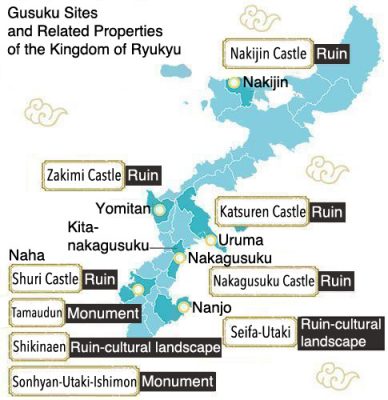
Traffic congestion caused by sightseeing buses was presenting challenges in the area surrounding Shuri Castle before it was ravaged by a fire last October. Similarly, Seifa-Utaki in Nanjo City welcomed around 30,000 visitors annually before it was added to the World Heritage List. In 2019, the number of visitors marked its highest record at about 470,000, according to the 2019 Tourism Handbook Prefectural Tourism Statistics, indicating the urgent need to address over-tourism.
Since the Seifa-Utaki and the Sonohyan-Utaki are religious monuments and are considered sacred, there are calls to conserve the natural environment surrounding them. Meanwhile, Nakijin Castle, which was partially destroyed in a typhoon, is currently being studied for restoration.

Shuri Castle was burned down in a fire on Oct 31, 2019. The underground structure located beneath the main hall is currently viewable from all directions through a protective glass installation.
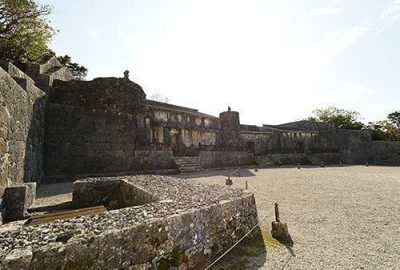
Tamaudun, in Shuri, Naha City

Sonhyan-Utaki-Ishimon in Shuri, Naha City
Disaster prevention Fire extinguishing measures added to Shuri Castle; preventing castle wall collapse
The October 2019 Shuri Castle fire destroyed its main hall, other reconstructed buildings, and damaged some of the underground structures, all of which were previously open to the public. In 2018, a section of Nakijin Castle’s stone wall collapsed during a typhoon. To uphold the historical and cultural significance of the World Heritage Sites, local governments are turning their attention to crisis management, including the COVID-19 pandemic, in addition to disaster and fire prevention.
■ Shuri Castle
After the Shuri Castle fire, the Japanese government took steps to protect what remained, and the grounds were reopened to the public in June this year. The reconstruction of the main hall will begin in the 2022 fiscal year and is scheduled for completion in 2026. Fire sprinkler systems, which were previously absent, will be added during the reconstruction work, and indoor fire hydrants will be upgraded; the corridors connecting the main hall to its surrounding buildings will be outfitted with fire shutters. Learning from the Shuri Castle fire, Naha City is re-examining its fire prevention measures for wooden structures elsewhere, such as the Shikinaen.
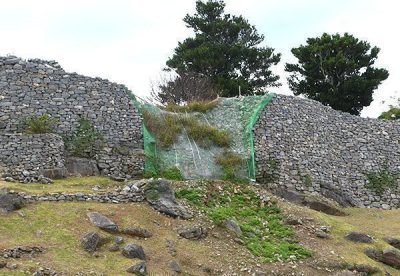
A net is placed over a section of Nakijin Castle’s stone wall, which collapsed during a 2018 typhoon (photographed on Nov 28, 2020).
■ Nakijin Castle
Nakijin Castle’s stone wall was partially destroyed during a typhoon; its restoration is still under discussion, as the internal structure of the wall is currently under study. Steps have been taken to improve the durability of the stone wall, such as preemptively disassembling and reassembling sections of the wall that were at risk of collapsing. Yasushi Tamaki, head of the local Cultural Assets Department, said, “Dealing with a World Heritage property, our priority is to preserve its authenticity in order to convey the correct history of the site.”
■ Seifa-Utaki
The Nanjo City Tourism Association, together with the Amamikiyo Roman Guide Group (the group offers sightseeing tours of Seifa-Utaki), is providing its staff with lifesaving AED training. Additionally, as a precaution against the novel coronavirus pandemic, the association has also prohibited tourists from entering the sangui, the sacred triangular rock formation, to avoid the three C’s (crowded places, close-contact settings, and confined spaces).
The Nanjo City Commerce and Tourism Department normally closes the sites to visitors in a disaster, such as heavy rain. The secretary-general of the city’s tourism association, Hideki Yaga, said, “We want to raise awareness of disaster prevention in tourism in cooperation with the city, to better prepare for unexpected events such as earthquakes—not just heavy rain.”
Over-tourism Problems arise as tourism surge—tackling traffic congestion and parking space shortages
The World Heritage Sites throughout Okinawa saw a surge in tourism after they were inscribed on UNESCO’s list. Each municipality has made various efforts to meet the needs of its tourists. However, a conflict exists between preserving the local culture of revering the sites as sacred ground and preserving them as cultural property.

Gates were installed at the Seifa-Utaki to prevent visitors from entering the triangular rock formation known as the sangui located in Kudeken, Chinen, Nanjo City.
■ Seifa-Utaki
The status of Seifa-Utaki as a sacred ground has posed challenges for Nanjo City. Visitors to Seifa-Utaki reached 434,000 in 2013, causing traffic congestion for locals. Complaints were subsequently filed by residents as well as visitors whose primary purpose was to pray at Seifa-Utaki. In order to relieve traffic congestion, the city relocated the parking lot to the Nanjo City-Ganju Station. It also designated bi-annual closures (six days per year in total) to preserve the site’s historical and environmental characteristics. The Nanjo City Commerce and Tourism Department explained that it intends to safeguard the cultural property while promoting tourism without fixating too much on tourism statistics.
Hideki Yaga, secretary-general of the city’s tourism association, stressed, “We can add to Seifa-Utaki’s value as a ‘sacred place’ by protecting the site and its surrounding nature.”
■ Shuri Castle, Shikinaen, and Tamaudun
In the fiscal year 2018, about 2,806,000 visitors traveled to the national Shuri Castle park area, causing traffic congestion. One of the goals of rebuilding Shuri Castle is to design a community where tourists and residents can co-exist.
After the Shuri Castle fire, the number of visitors at Shikinaen and Tamaudun surged temporarily. In October 2019, the Shikinaen welcomed about 5,000 visitors, compared to 20,000 the following November, after the fire; the increased traffic damaged the site’s cobblestones.
Visitors dropped this year due to the pandemic. Still, Naha City Curator Yu Suzuki is thinking ahead: “We need to figure out the maximum number of visitors that will maintain a tranquil atmosphere.”
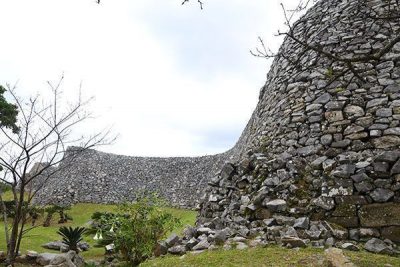
Nakijin Castle Ruins in Imadomari, Nakijin.
■ Nakijin Castle
At the Nakijin Castle remains, the English translation of the information board is being revised. Yasushi Tamaki, the head of the Nakijin Cultural Assets Department, is confident that “[the new translation] will make Okinawa’s unique spiritual culture more intelligible.” More than half of the translation is complete.
■ Nakagusuku Castle
Nakagusuku Village, where Nakagusuku Castle is located, faces challenges in multilingualization, such as training tour guides to assist visitors from abroad. Furthermore, since there are no permanent exhibitions currently installed at Nakagusuku Castle, there is no way to communicate the significance of the gusuku (castle). The premises also lack parking space to accommodate guests during large scale events.
Enticing tourists Historical and cultural exhibits, events, and facility improvements
To further disseminate the appeal of the World Heritage Sites, each municipality has turned its attention to enticing tourists by improving nearby facilities. Events using projection mapping, in which images are projected onto the castle’s stone walls, are gaining popularity.
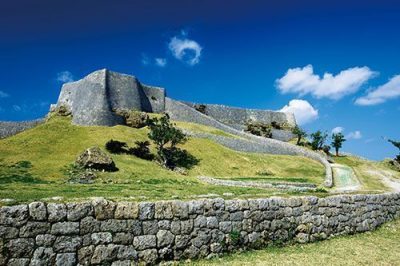
Katsuren Castle Ruins in Haebaru, Katsuren, Uruma City
■ Katsuren Castle
The Katsuren Castle grounds is currently undergoing a major development project. Two facilities are scheduled to open across the street from the ruins: A facility containing restaurants and shops for local products, which will open in 2024, and a second dedicated to exhibits and displays.
The latter is slated to open its doors next summer, and will contain a theater equipped with a large screen. It will also house a permanent exhibit room to showcase the history and culture of Uruma City. The exhibit will allow visitors to learn about the city’s WWII battle sites and its history of bullfighting. Riki Kishimoto, head of the Uruma City Katsuren Castle Remains Maintenance Office, explained, “Photo and video footage, and cultural goods will be displayed to illustrate the histories of Katsuren Castle and the Ryukyu Kingdom.”

Nakagusuku Castle was one of the first heritage sites to hold a projection mapping event. Photographed in Nagakugusu Village in December 2013.
■ Nakagusuku Castle
In Okinawa, Nakagusuku Castle has been the trailblazer in holding projection mapping and concert events. The site is equipped with a plaza that can hold up to 9,000 people, and utilizing the projection mapping events funded by the Okinawa Promotion Grant, it has gradually gained recognition since 2013.
Although the pandemic poses new challenges for holding events, the Nakagusuku Village Industrial Promotion Division representative is hopeful: “Since it is an outdoor event, we can still engage guests if we can market [the event] as a place to see the ruins while taking coronavirus precautions.”
■ Shuri Castle
At the end of October this year, the prefectural government also employed projection mapping at Shuri Castle, to add momentum to the reconstruction work. However, some visitors were seen climbing onto the Sonohyan-Utaki-Ishimon in an attempt to take photos of the projection. UNESCO recognized the utaki for having ties to the unique Ryukyuan religious beliefs. Naha City Curator Yu Suzuki said, “We hadn’t paid close attention to the spiritual aspects of the gusuku and its related heritage sites. We must protect the ruins themselves, but we should be maintaining an environment that is appropriate for religious symbols.”
■ Zakimi Castle
The Yuntanza Museum, located at the foot of the Zakimi Castle Remains, reopened in 2018 after undergoing renovations. Visitors can now learn about the castle ruins and the history, tradition, and culture of Yomitan Village. The museum has been well received by visitors from inside and outside the prefecture.
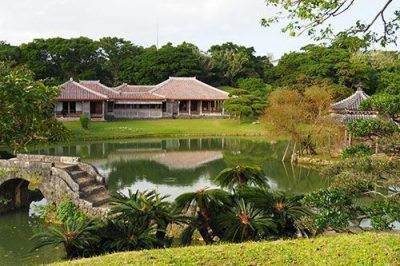
Shikinaen in Maaji, Naha City
[Terminology] World Heritage
The United Nations Educational, Scientific and Cultural Organization (UNESCO) selects and designates World Heritage Sites to protect cultural and natural heritage around the world considered to be of outstanding value. Once a site is inscribed on the World Heritage List by the World Heritage Committee, it receives various protection and assistance from the Heritage Fund. The pyramids in Egypt and the Great Wall of China are such sites. In Japan, 23 sites (as of July 2019) are listed, including Buddhist buildings in the Horyuji area of Nara Prefecture and the Atomic Bomb Dome in Hiroshima Prefecture.
(English translation by T&CT and Monica Shingaki)
Previous Article:300 stories of the Ikema people from Miyakojima captured in publication released by Ikema Cultural Association
Next Article:Yomitan requests Defense Bureau access to place of worship located on U.S. military base
[Similar Articles]
- World Heritage site Nakijin Castle wall collapses due to Typhoon Number Seven
- Nakagusuku and Katsuren castle ruins rank among Japan’s best 20 castles
- Seifa Utaki the sacred prayer site to close six days a year from 2012 for preserve the environment
- Hokuzan king makes an appearance at Nakijin Castle at night! The world heritage site’s castle wall get a vibrant light-up display
- Residents decorate Nakagusuku castle ruins with fourteen shisa
 Webcam(Kokusai Street)
Webcam(Kokusai Street)


